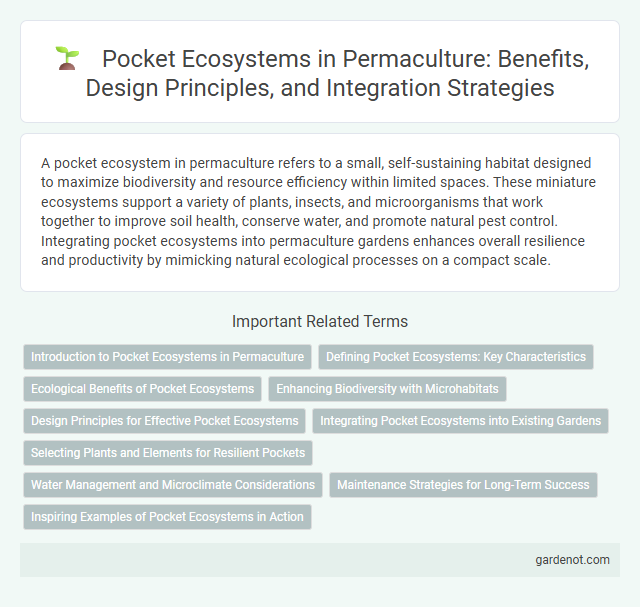A pocket ecosystem in permaculture refers to a small, self-sustaining habitat designed to maximize biodiversity and resource efficiency within limited spaces. These miniature ecosystems support a variety of plants, insects, and microorganisms that work together to improve soil health, conserve water, and promote natural pest control. Integrating pocket ecosystems into permaculture gardens enhances overall resilience and productivity by mimicking natural ecological processes on a compact scale.
Introduction to Pocket Ecosystems in Permaculture
Pocket ecosystems in permaculture are compact, self-sustaining environments designed to maximize biodiversity and resource efficiency within small spaces. These mini-ecosystems integrate plants, animals, and microorganisms to create synergistic relationships that enhance soil fertility, water retention, and pest control. By mimicking natural ecological processes, pocket ecosystems support resilient and productive permaculture systems in urban gardens, balconies, and limited land areas.
Defining Pocket Ecosystems: Key Characteristics
Pocket ecosystems are small, self-contained habitats that support diverse plant and animal life within urban or suburban settings. These microhabitats exhibit high biodiversity, efficient nutrient cycling, and resilience to environmental stressors, reflecting core permaculture principles. Key characteristics include compact size, species interdependence, and sustainable resource management, making them vital for ecological balance in developed areas.
Ecological Benefits of Pocket Ecosystems
Pocket ecosystems enhance urban biodiversity by providing microhabitats for pollinators, birds, and beneficial insects. These small-scale green spaces improve air quality and help moderate local temperatures through natural cooling effects. They also support soil health by promoting nutrient cycling and water retention, reducing urban runoff and erosion.
Enhancing Biodiversity with Microhabitats
Pocket ecosystems create diverse microhabitats that support a wide range of flora and fauna, enhancing local biodiversity by providing shelter, food sources, and breeding grounds. These small-scale environments promote ecological balance by encouraging beneficial insects, pollinators, and soil organisms essential for sustainable permaculture systems. Integrating pocket ecosystems into permaculture designs increases resilience and productivity by fostering interconnected living communities.
Design Principles for Effective Pocket Ecosystems
Effective pocket ecosystems rely on principles such as maximizing biodiversity by incorporating native plants, creating microhabitats to support varied wildlife, and ensuring water efficiency through rainwater harvesting and mulching techniques. Designing compact, layered vegetation structures enhances nutrient cycling and soil health, while strategic placement of elements like compost bins and pollinator-friendly species boosts ecosystem resilience. Integrating these design principles promotes sustainable, self-sufficient microhabitats that contribute to broader permaculture goals.
Integrating Pocket Ecosystems into Existing Gardens
Integrating pocket ecosystems into existing gardens enhances biodiversity by creating microhabitats tailored to native plants and beneficial insects. These small-scale ecological niches improve soil health and water retention, fostering resilience against pests and climate variations. Strategic placement near vegetable beds or pollinator-attracting flowers maximizes nutrient cycling and supports ecosystem services within permaculture designs.
Selecting Plants and Elements for Resilient Pockets
Selecting plants and elements for resilient pocket ecosystems involves prioritizing native, drought-tolerant species that support local biodiversity and soil health. Integrating a mix of perennials, nitrogen-fixing plants, and attractive pollinator-friendly species enhances ecosystem stability and productivity. Incorporating microhabitats such as mulch layers, insect hotels, and water catchment features increases resilience against environmental stressors.
Water Management and Microclimate Considerations
Pocket ecosystems in permaculture optimize water management by capturing and retaining rainwater through swales, rain gardens, and permeable surfaces to enhance infiltration and reduce runoff. Microclimate considerations include planting strategic vegetation to provide shade, windbreaks, and humidity regulation that improve plant resilience and water efficiency. Integrating greywater recycling and mulching techniques further maintains soil moisture and promotes a balanced, sustainable microenvironment.
Maintenance Strategies for Long-Term Success
Pocket ecosystems thrive through regular pruning, mulching, and soil health monitoring that support biodiversity and resource efficiency. Implementing integrated pest management and water conservation techniques helps maintain ecosystem balance and resilience against environmental stressors. Consistent observation and adaptive adjustments based on seasonal and climatic changes ensure sustainable productivity and long-term ecological success.
Inspiring Examples of Pocket Ecosystems in Action
Pocket ecosystems demonstrate sustainable urban biodiversity by transforming small spaces into thriving habitats teeming with native plants, pollinators, and beneficial insects. Examples include micro-forests in city parks, rooftop gardens supporting bird populations, and community rain gardens that reduce runoff while fostering amphibian life. These projects highlight how compact ecosystems enhance ecological resilience and urban food security through permaculture principles.
Pocket ecosystem Infographic

 gardenot.com
gardenot.com